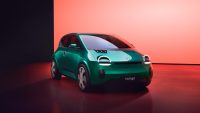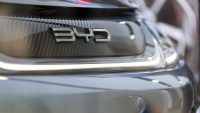New car registrations rose in July and marked two years of consecutive monthly growth – but fleet sales accounting entirely for the month’s rise is a ‘concern’.
Latest figures from the Society of Motor Manufacturers and Traders (SMMT) reveals new car registrations jumped by 2.5%.
With 147,517 cars hitting the roads, it was the best July since 2020 when showrooms reopened following the first lockdown.
However the figures also show that the rise was down entirely to fleet sales, as private buyers continued to have cold feet over new cars.
The fleet sector recorded a 13.0% increase in registrations in July to achieve a 62.0% market share.
Private demand, meanwhile, fell by 11.1% to account for 36.2% of deliveries in the month – though the SMMT did counter this with the observation that the growing popularity of salary sacrifice purchasing will contribute to this decline.
SMMT chief Mike Hawes said this weakening of retail demand is a ‘concern’.
Electrified cars accounted for four in 10 new cars registered in July.
Hybrid electric vehicle (HEV) uptake increased by 31.4% to achieve a 14.5% market share, while plug-in hybrids (PHEV) grew 12.4% to take 8.9% of registrations.
Battery electric vehicle (BEV) volumes, meanwhile, were up 18.8%, resulting in an overall market share of 18.5%.
The SMMT said that while the private share of the BEV market continues to fall – 17.2% went private buyers, compared with 20.3% last year – private BEV volumes did increase by a marginal 0.9%.
Overall, BEVs account for 16.8% of the new car market, year to date.
The Kia Sportage was the month’s best-seller, notching up 3,999 registrations, followed by the Nissan Qashqai (3,633) and the Ford Puma (3,418).
Only the Volkswagen Golf in fifth (3,009) and its smaller sibling Polo in ninth (2,541) were hatchbacks – all other cars in July’s top 10 best-sellers chart were SUVs and crossovers.
The Ford Puma continues to lead the way in the year-to-date chart with 29,792, followed by the Sportage (28,138) and the Qashqai (26,514).
Commenting on the figures, Hawes said: ‘Two years of new car market growth against a backdrop of a turbulent economy is testament to the sector’s resilience and the attractiveness of the deals on offer.
‘Weakening private retail demand, however, particularly for EVs and despite generous manufacturer discounts, is the over-riding concern.
‘More people than ever are buying and driving EVs but we still need the pace of change to quicken, else the UK’s climate change ambitions are threatened and manufacturers’ ability to hit regulated EV targets are at risk.
‘Achieving market transition at the pace demanded requires greater support for consumers and, with the all-important new numberplate month of September beckoning, action on incentives and infrastructure is needed now.’
What the industry thinks
New EV incentives needed
New car sales are up on this time last year, with fleets continuing to be the driver of growth in the market. Benefit-in-kind and salary sacrifice incentives for business have been the major driver of growth in EV sales and market share for some time now. The evidence increasingly suggests that accelerating private EV sales may require similar incentivisation, particularly if the government is going to reinstate the 2030 end to new petrol and diesel vehicle sales.
While choices in the new car market are improving, EV prices and the scale and rate of price depreciation when buying from new remain major barriers to convincing consumers to buy a new EV. Subsequently, many consumers that are looking to transition to an EV are deciding that the used EV market is a more attractive way to do that.
Despite used EV sales growing, the higher rate of stock that is currently coming into the used market is still pushing the price of some models down even further.
All of this context continues to pose big questions regarding how car makers will meet their Zero Emission Mandate targets.
Richard Peberdy, UK head of automotive, KPMG
Carmakers working hard to entice customers
Overall, July marked another lacklustre month for the new car market, as the strong performance in fleet channels struggled to offset the ongoing retail decline.
The bright spot is a strong consumer move to low emission cars, which so far this year have accounted for almost half of all new car sales, up from around just one in ten in 2019.
Manufacturers are also working hard to tempt buyers with enticing offers, as shown by a 20% rise in new car advert views on our platform in July. That offers some optimism as we approach the key plate change month of September.
Ian Plummer, commercial director, Auto Trader
High price of EVs remains a barrier
Though another rise in new registrations is positive, concerns still remain surrounding consumer demand. Fleet statistics continue to have a significant impact on the registrations data, especially for electric vehicles (EVs).
The high upfront cost of EVs and the lack of affordable options continues to act as a barrier for motorists contemplating the switch from petrol and diesel cars, and further investment is required to bring the charging infrastructure up to scratch. However, our research amongst EV drivers found that the overwhelming majority (92%) of those who have made the switch to EV are happy with their car and would purchase another one. And 61% have saved money on running costs.
Manufacturers and motorists will now be looking to the new government to provide new and updated incentives to encourage more people to make the change, which will be key to ensuring the Zero Emission Vehicle (ZEV) mandate is achievable.
Lisa Watson, director of sales, Close Brothers Motor Finance
Electric cars falling short of targets
The UK’s new car market continued its growth in July, marking 24 consecutive months of expansion. This increase was primarily driven by the fleet sector, which, while crucial, underscores a potential risk.
A heavy reliance on this segment distorts reality – a healthy retail market is equally vital for manufacturers’ long-term profitability.
Although BEV uptake is rising, it still falls short of mandated targets. However, the potential for BEVs is significant, and we expect them to play a major role in the market outlook for 2025.
It is too soon to know what impact, if any, the new government’s growth plans will have on consumer confidence, though the Bank of England’s base rate reduction last week was a positive and welcome sign.
Our baseline forecast is marginally more optimistic than the SMMT’s projections, but we continue to monitor movements closely and caution that Q4 could see some dramatic movements as manufacturers manoeuvre to avoid ZEV penalties.
Philip Nothard, insight director, Cox Automotive


































